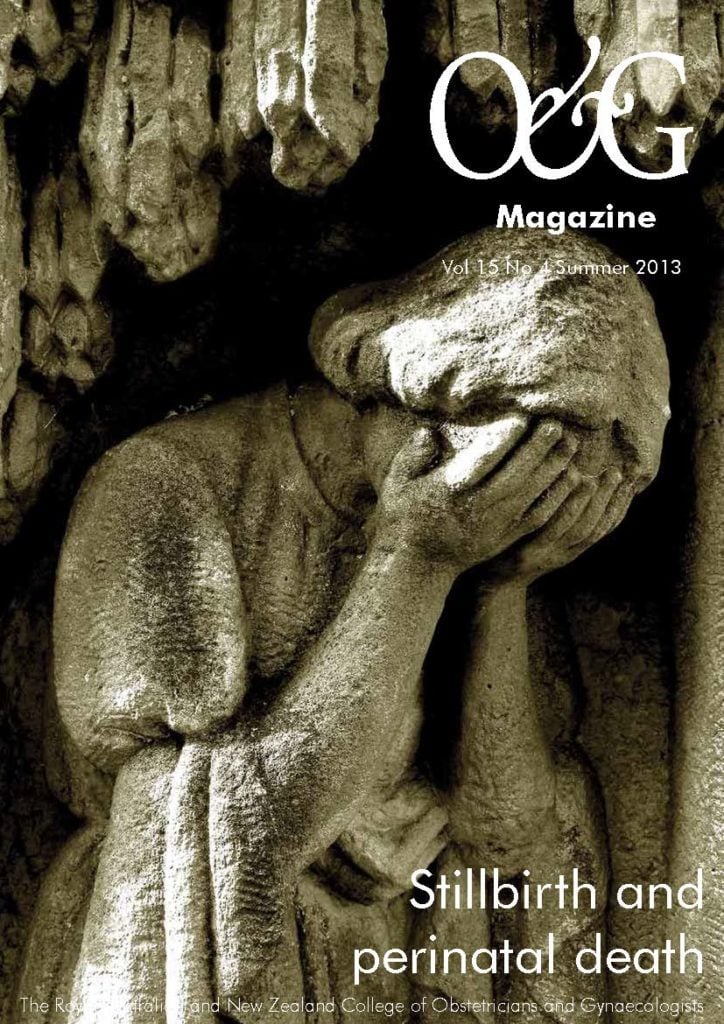The scope of stillbirth has been overlooked by many, in part, because there is a tendency to have a fatalistic view: if a baby dies before birth ‘it was God’s will’.
Few would estimate that, in high-income countries, late stillbirths (pregnancies 28 weeks or later) occur twice as often as death owing to HIV/AIDS; are ten times more common than deaths owing to Hepatitis B; twice as common as deaths owing to congenital anomalies; twice as common as deaths owing to preterm complications and ten times more common than sudden infant death syndrome (SIDS).1 The above conditions are not unfamiliar to the obstetric provider who spends considerable time and resources to review benefits of screening for HIV and hepatitis B, and to offer an ever-expanding menu of options for screening for inherited conditions, congenital anomalies and chromosomal abnormalities. However, all of these conditions occur less commonly than late stillbirth. Rarely is the risk of late stillbirth discussed and, until recently, there were few references to stillbirth in the lay press.
It is not unexpected that the unfortunate members of the ‘stillbirth club’ have begun to demand answers to the question why did their baby die and have looked to other bereaved parent groups. More than 30 years ago, sudden infant death syndrome (SIDS) parents pressed researchers to find answers and, as a result, resources were procured and researchers began the study of SIDS, including a complete death scene analysis, comprehensive history and complete autopsy. From this research, multiple modifiable risk factors for SIDS have been identified (prone sleeping, smoking and co-sleeping, among others). Since 1994, with parental education, there has been more than a 60 per cent decline SIDS deaths.2
Thirty years later, we are starting to unravel the puzzle pieces of stillbirth and research has led to some important observations that help reveal some of the potential causes of stillbirth and some previously under-appreciated risk factors for stillbirth. Currently, in high-income countries, the chance after a woman reaches 20 weeks of gestation that her pregnancy might end in a stillbirth is 1/160.3 4
For mothers and families there are many downstream consequences of stillbirth, the most significant and long-lasting being experienced by mothers. Women who experience stillbirth are at an increased risk of multiple maladies including depression, anxiety and post-traumatic stress disorder, somatisation disorder and family disorganisation.5
The terms fetal death, fetal demise, stillbirth and stillborn all refer to the delivery of a fetus showing no signs of life. In the lay press most parents prefer the term stillbirth. The World Health Organisation (WHO) defines stillbirth as a ‘fetal death late in pregnancy’ and allows each country to define the gestational age at which a fetal death is considered a stillbirth for reporting purposes. The gestational age that divides what is considered a miscarriage from a stillbirth is often legally defined within a country, and may or may not include terminations of pregnancy related to congenital anomalies or spontaneous preterm losses that are induced to reduce the risk of sepsis to the mother.6 In Australia and New Zealand, a stillbirth is defined as a fetal demise after 20 completed weeks of gestation and if the gestational age is not known, a fetus that weighs 400g or greater.7
Trends in stillbirth rates
The study of trends in the reduction of stillbirth can be seen in historical cohorts and among developing countries. These studies identify factors that affect stillbirth rates and are therefore most amenable to change. Vallgarda reviewed stillbirths in Denmark from 1938 to 1947 (defined as fetal death after 32 weeks gestation) and found that during this time period, stillbirths were reduced from 24.9 to 16.3 per 1000 births (a 35 per cent reduction). This correlated with a reduction in the numbers of women having births at home (reduced from 50 per cent of births to 35 per cent of births).8 In addition, in 1945, Denmark introduced a law that provided free antepartum care, which was widely used by women (70 per cent of women initially attended prenatal care and by the 1960s this had risen to almost 100 per cent).9 In developing countries, the addition of trained birth attendants, the availability of antibiotics and to timely access to caesarean section has greatly reduced the risk of intrapartum fetal deaths. 10 In developed countries, the types of stillbirths most noted to have decreased have occurred where there have been specific strategies implemented to reduce risk. As a result, fetal deaths related to asphyxia in labour, Rhesus disease, congenital malformations and disease of the mother have been reduced.11 Currently, the most common types of late fetal death are related to diseases of the placenta (causing fetal growth restriction and, more acutely, placental abruption) and some cord accidents, but unfortunately a large proportion are unexplained even after a thorough evaluation.12 13
References
- World Health Organization. Definitions and indicators in Family Planning Maternal & Child Health and Reproductive Health. Geneva: WHO Press, 2001.
- Task Force on Sudden Infant Death Syndrome. The changing concept of Sudden Infant Death Syndrome: diagnostic coding shifts, controversies regarding the sleeping environment, and new variables to consider reducing risk. Pediatrics. 2005;116: 1245-1255.
- MacDorman MF, Munson ML, Kirmeyer S. Fetal and Perinatal Mortality United States 2004. National Vital Statistics Reports 56, Number 3, October 2007.
- Bascand G. Births and Deaths: year ended March 2011. Statistics New Zealand accessed 10/31/2013 www.stats.govt.nz .
- Cacciatore J, Schnebly S, Froen JF. The effects of social support on maternal anxiety and depression after stillbirth. Health and Social care in the Community 2009; 17:167-176.
- Papiernik E, Zeitlin J, Delmas D, et al. Termination of pregnancy among very preterm births and its impact on the very preterm mortality: results from 10 European population-based cohorts in the MOSAIC study. BJOG 2008;115:361-368.
- Bascand G. Births and Deaths: year ended March 2011. Statistics New Zealand accessed 10/31/2013 www.stats.govt.nz
- Vallgarda S. Why did the stillbirth rate decline in Denmark after 1940? Popul Stud 2010;64:117-30.
- Vallgarda S. Why did the stillbirth rate decline in Denmark after 1940? Popul Stud 2010;64:117-30.
- Lawn J, Shibuya K, Stein C. No cry at birth: global estimates of intrapartum stillbirths and intrapartum-related neonatal deaths. Bull. World Health Organ 2005;83:409-17.
- Fretts RC, Boyd M, Usher RH, Usher HA. The changing pattern of fetal death 1961-1988. Obstet Gynecol 1992;79:35-9.
- Froen JF, Gardosi JO, Thurmann A, Francis A, Stray-Pedersen B. Restricted fetal growth in sudden intrauterine unexplained death. Acta Obstet Gynecol Scand. 2004;83:801-7.
- Fretts RC. Etiology and prevention of stillbirth. Am J Obstet Gynecol 2005;193:1923-35.





Leave a Reply